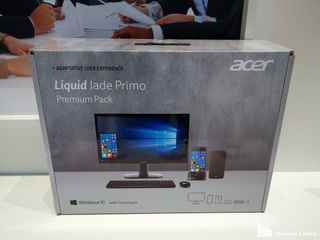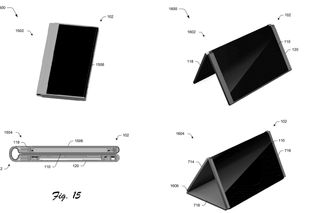Microsoft needs to leverage partnerships, eSIM and edge computing to position ultramobile PCs
Microsoft seems to be positioning its mobile efforts for a category-defining full Windows 10 ultramobile PC with phone capabilities. But how will Microsoft and its partners position and market ultramobile PCs if they become a reality?
The existence of Microsoft's mobile strategy is debatable. One fact is certain, however, Microsoft needs a mobile device to ensure present and future personal computing relevance.
Smartphones are at the center of technologies that are shaping the future computing landscape. Without a mobile device, Microsoft is solidifying its position as a non-participant in personal computing's consumer-driven future.
A potential ultramobile PC category may help Microsoft and its OEM partners carve out a new, initially niche, telephony-enabled PC category that addresses its absence in mobile but doesn't compete directly with smartphones. PC manufacturer partnerships, electronic or embedded SIM (eSIM), IoT, 5G, edge computing and the synergy of Windows 10 features are all important factors to the long-term positioning of what may potentially become an evolving new PC category.
Assuming this analysis is correct, and results in an actual device, how might Microsoft, OEM partners and Qualcomm position and market ultramobile PCs?
If it's a PC, sell it like a PC
Microsoft must avoid two major pitfalls while executing its mobile strategy. Selling a traditional smartphone against the competition is a no-brainer. The other, presuming ultramobile PCs are the goal, is trying to sell them through traditional smartphone channels. The PC distribution channels Microsoft and its manufacturing partners have established over the past 40 years may prove a more viable strategy.
With Surface and Windows 10, Microsoft inspired partners to build quality 2-in-1s and mobile-oriented PCs that are predicted to remain growing PC segments. These PCs take advantage of Windows 10 features like inking, gaming and more. Ultramobile PCs can be positioned to make use of these successful OEM relationships and range of Windows 10 features.
Ultramobile PCs can be sold through traditional retail and B2B distribution channels.
Existing PC retailers like Best Buy, Staples and Walmart could sell ultramobile PCs to consumers, and existing business-to-business (B2B) channels could sell to the enterprise. Like existing PCs in retail outlets, they can be displayed and packaged with peripherals like monitors, mice and keyboards, like the Continuum-enabled Acer Jade Primo Windows phone. Or like the HP Elite x3, it can be packaged with a Lap Dock-like peripheral. This potentially foldable device could be a tablet when unfolded, a phablet-sized handheld when folded and a laptop or desktop when docked.
Get the Windows Central Newsletter
All the latest news, reviews, and guides for Windows and Xbox diehards.

Like all technology, over time these devices will become more powerful, and we have evidence that Continuum will become more capable. Consequently, users could potentially create touchdown spots in homes and offices where ultramobile PCs would connect to stationed peripherals in place of old PC towers. Windows 10 on ARM can already run demanding PC tasks such as HD video playback, Inking, Adobe Photoshop, Halo Spartan and Office.
Since the telephony capabilities of ultramobile PCs are not the focus, positioning them as PCs is strategically appropriate and helps avoid carriers as the primary means of distribution.
eSIM and 'bypassing' carriers
Windows 10 on ARM doesn't support telephony yet, but we're conceivably moving swiftly in that direction. With Qualcomm's integrated eSIMs, Microsoft's partners are bringing always-connected, cellular PCs to market beginning this year. eSIMs require less space, allow for lighter and thinner devices, and enable connected devices to be recognized on cellular networks just as traditional SIM cards do. They also allow users greater flexibility with choosing cellular providers. Consumers will have on-device ability to switch between carriers and plans as they see fit and to purchase data directly from the Windows Store.
Microsoft announced carrier and OEM partnerships for cellular PC vision.
eSIMs on tablets are nothing new. But if cellular PCs segue to telephony-enabled ultramobile PCs, the flexibility in carrier choice for voice and not just data helps Microsoft step back into the phone space "from a side door" while still not competing directly with smartphones.
Telephony-enabled ultramobile PCs could offer flexible telephony options to the mobile space.
If iPhone and Android phone users purchase an ultramobile PC for PC purposes, they would in effect have a second "phone." This trojan phone effect could be a slow and methodic strategy to bring flexible telephony options to the mobile space.
The GSM Association (GSMA), a body of over 800 mobile carriers, has standardized eSIM guidelines. If Microsoft progresses from eSIM-capable cellular PCs to telephony-enabled ultramobile PCs, it will be following the evolution of supporting technologies.
IoT, 5G and the edge of the cloud
Edge computing allows IoT and connected devices with increasingly powerful processors, that are close to users, to handle much of the processing previously relegated to the cloud.

Reduced latency (time it takes data to reach connected devices), increased processing power and proactive abilities of AI on devices on the clouds edge (like mobile devices) are some advantages of edge computing.
What is Microsoft's intelligent edge and how does it affect mobile?
Qualcomm's CEO Steve Mollenkopf describes it this way:
[When] you touch something hot, your muscles move away from that hot thing before your central nervous system even knows it. Because that information is so important to take an action on that...processing has to occur locally. More...of the interesting things that happen in the connected Internet of Things will happen in that way.
The imminent implementation of 5G networks will add more capacity and greater data rates to the lower latency that edge computing enables. Mollenkopf says data centers can "essentially be moved closer to where data is used making distributed computing happen." Ultramobile PCs as part of distributed networks could be one business model Microsoft envisions. Monitoring and acting upon the real-time status of equipment or processes may be more efficient on such devices in that context.
Living on the edge
Ultramobile PCs would be positioned (with billions of other IoT devices) on the edge of Microsoft's cloud.
This perspective potentially reveals how Microsoft's cloud strategy works in accord with its mobile objectives. A new category of highly mobile PCs that take advantage of the processing power on the intelligent edge could leverage AI and other high-data processing tasks.
Microsoft may envision a consumer model where ultramobile PCs proactively communicate with connected cars (for which Microsoft provides cloud support) or a growing number of other connected consumer appliances and IoT devices.
If this view is accurate Microsoft's cloud initiatives are forward-looking and foundational to a potential mobile computing paradigm which benefits from edge computing, 5G networks, Microsoft's cloud and Qualcomm's vision of mobile computing's future.
Windows 10, a synergy of features
Microsoft's personal computing strategy is driven by its one-Windows vision to bring the power of Windows to all form factors.
I believe Microsoft intends for ultramobile PCs to present a synergy of Windows 10 features. They would be a single device useful for a range of creative, productive and leisure purposes, including:
- Windows Ink and digital notepads.
- Windows Mixed Reality and virtual and augmented reality handsets.
- Continuum and desktop or laptop PCs.
- Windows gaming and Xbox as a powerful gaming platform.
- Composable Shell (CShell) as a consistent context-conforming UI experience.
- Cloud and AI to leverage Microsoft's Azure, AI and edge computing investments.

The synergy of these features on unique PC form factors optimizes the benefits of edge computing that may make this device Nadella's ultimate mobile device.
Microsoft and partners can market a unique experience.
Such a device would not categorically be a productivity, leisure, business or consumer device. It would be all these things. Microsoft and its partners could potentially market the unique experience Windows 10 ultramobile PCs may offer.
Following the breadcrumbs
This speculative analysis offers an outlook of how current and evolving technological infrastructure could support the positioning and distribution of a new telephony-enabled PC category.
With a Windows 10-driven strategy, and eSIM, IoT, edge computing and unique hardware investments, Microsoft may be en route to Nadella's ultimate mobile device.
Jason L Ward is a columnist at Windows Central. He provides unique big picture analysis of the complex world of Microsoft. Jason takes the small clues and gives you an insightful big picture perspective through storytelling that you won't find *anywhere* else. Seriously, this dude thinks outside the box. Follow him on Twitter at @JLTechWord. He's doing the "write" thing!
